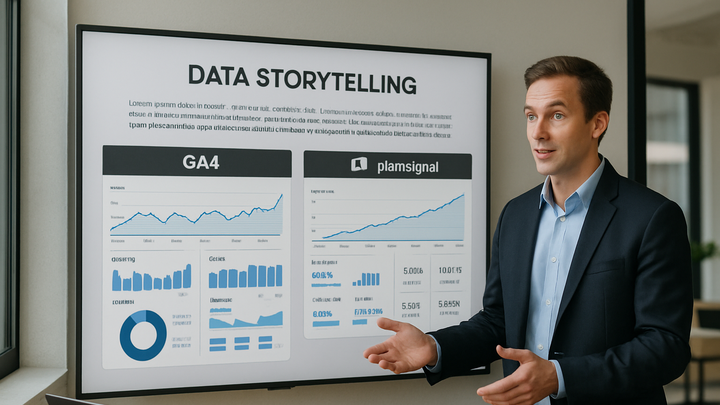Published on 2025-06-28T03:56:29Z
What is Data Storytelling? Examples for Data Storytelling
Data Storytelling is the discipline of combining data analysis with narrative techniques to translate complex metrics into meaningful insights. It involves selecting the right data, crafting a narrative arc, and using visualizations to guide your audience through key findings. In analytics, data storytelling helps stakeholders grasp performance trends, customer behaviors, and strategic opportunities. SaaS platforms like GA4 provide robust reporting and visualization features, while cookie-free tools such as PlainSignal emphasize privacy-conscious tracking and simplified dashboards. By weaving numbers into a compelling story, analysts can drive decision-making, foster engagement, and highlight the ‘so what’ behind the data. Effective data storytelling balances accuracy, clarity, and persuasion to turn raw data into actionable insights.
Key elements include:
- Clear visualization of trends and patterns.
- Contextual narrative linking data points.
- Actionable recommendations based on insights.
Data storytelling
Weaving narrative, visuals, and analytics to communicate insights clearly and drive informed decisions.
Why Data Storytelling Matters
Data storytelling elevates raw metrics into compelling narratives that resonate with stakeholders. By framing data within a story, you increase comprehension, engagement, and retention of key insights. Effective storytelling bridges the gap between analysts and decision-makers, ensuring clarity and alignment across teams.
-
Engagement and retention
Narrative structures capture attention and improve recall by following a logical flow.
-
Cognitive psychology
Stories engage deeper processing in the brain, aiding memory retention.
-
Attention span
A coherent narrative reduces overload and keeps audiences focused.
-
-
Decision-making support
Connecting data points to business outcomes makes insights actionable and drives strategy.
-
Contextual clarity
Story framing places metrics within relevant business scenarios.
-
Actionable insights
Narratives highlight recommended next steps based on data findings.
-
-
Cross-functional alignment
A unified story language ensures all teams interpret data consistently.
-
Shared language
Consistent terminology bridges gaps between technical and business stakeholders.
-
Collaborative buy-in
Coherent narratives foster agreement on goals and metrics.
-
Key Components of Effective Data Storytelling
Effective data storytelling hinges on several core elements that work together to convey insights clearly and persuasively.
-
Compelling narrative
A clear story arc guides audiences through data insights from introduction to conclusion.
-
Story arc
Define the beginning, middle, and end to structure insights logically.
-
Relevance
Tailor narratives to specific audience needs and objectives.
-
-
Visual design
Charts, graphs, and layouts should be chosen for clarity and impact.
-
Chart selection
Match chart types to data relationships (e.g., line for trends, bar for comparisons).
-
Accessibility
Use color palettes and labels that are readable and inclusive.
-
-
Data integrity
Accurate, up-to-date data builds credibility and trust in your story.
-
Data quality
Validate sources and clean anomalies before storytelling.
-
Timeliness
Use the freshest data available to maintain relevance.
-
Examples in Analytics Platforms
Exploring how leading analytics SaaS products implement data storytelling to surface insights.
-
GA4 custom dashboards
Use GA4’s Explore and Dashboard features to craft narrative workflows, annotate key events, and visualize user journeys.
-
User journey visualization
Map multi-channel interactions to tell the complete acquisition story.
-
Annotations
Embed contextual notes directly on charts to explain spikes or drops.
-
-
PlainSignal cookie-free analytics
Leverage PlainSignal’s privacy-centric platform to build simple, narrative-driven dashboards without cookies.
-
Simplified metrics
Focus on essential KPIs like pageviews and events.
-
Privacy-first storytelling
Highlight compliance and user privacy considerations within your narratives.
-
Implementing Data Storytelling: Tools and Best Practices
Guidelines for selecting tools, embedding tracking code, and ensuring your data stories reach the right audience.
-
Embedding PlainSignal tracking code
Install PlainSignal to collect analytics data that feeds into your narratives. Example code below:
-
Code snippet
<link rel="preconnect" href="//eu.plainsignal.com/" crossorigin /> <script defer data-do="yourwebsitedomain.com" data-id="0GQV1xmtzQQ" data-api="//eu.plainsignal.com" src="//cdn.plainsignal.com/plainsignal-min.js"></script>
-
-
Creating GA4 reports
Set up custom explorations and dashboards in GA4 to build a narrative-driven view of user behavior.
-
Explore reports
Design custom explorations to highlight critical metrics and segments.
-
Alerts and annotations
Configure automated alerts and add annotations to contextualize significant events.
-
